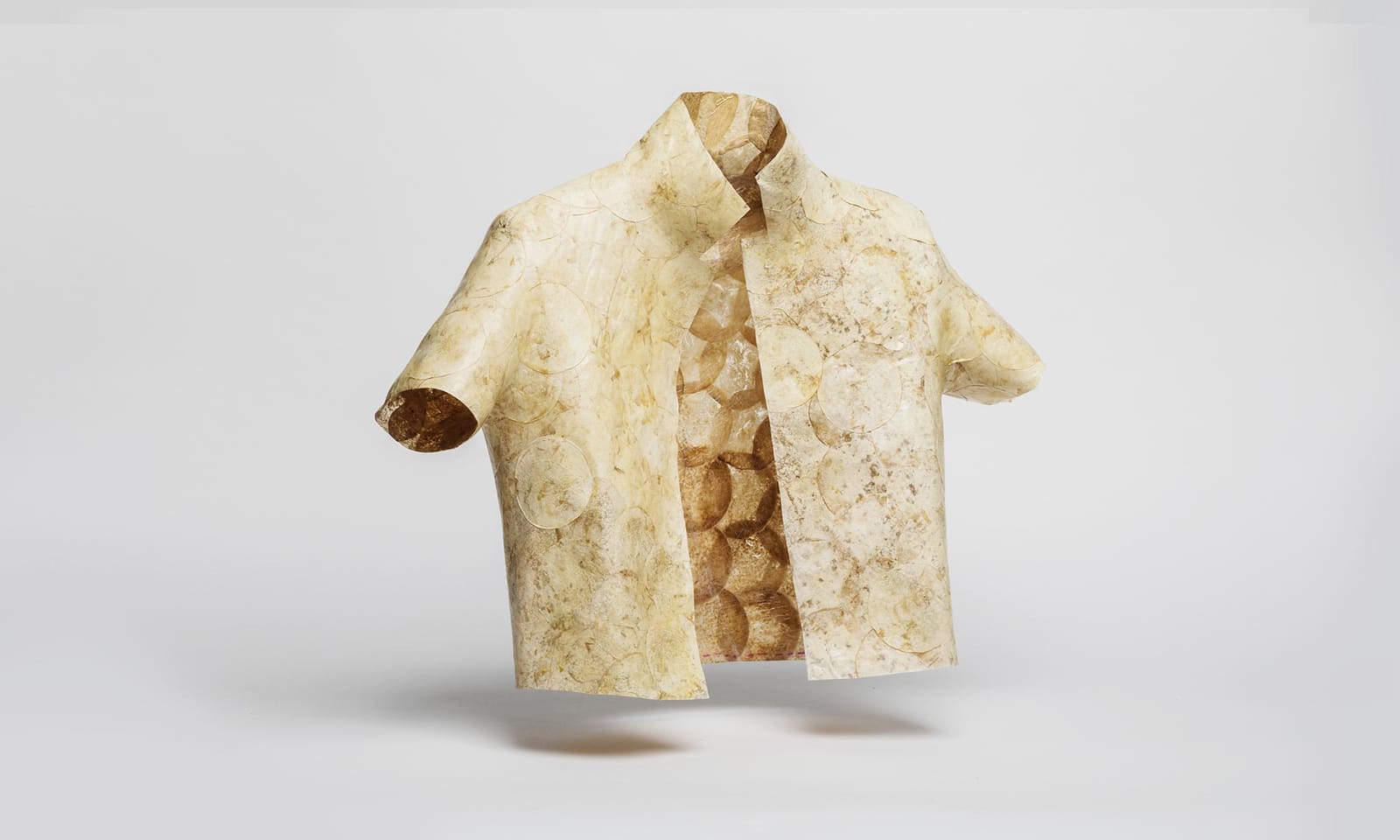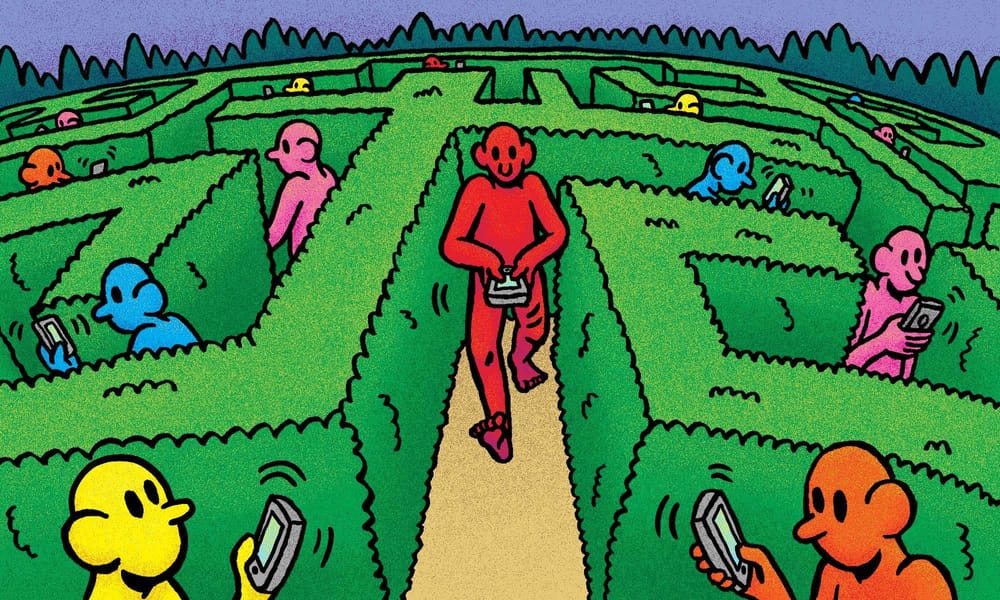Every year, the fashion industry generates over 92 million tonnes of textile waste, is responsible for over 190,000 tonnes of microplastics found in the ocean and produces nearly 20 percent of the world’s wastewater, making it one of the biggest polluters in the world, second only to oil. Is there a solution? Potentially, in biotechnology. In our interview series Fashion Futures, we explore the organisations and innovations presenting us with a more sustainable future: from textiles grown from fungus and dyed by microbes to algae clothing that can turn carbon dioxide into oxygen.
Multidisciplinary artist and designer Aniela Hoitink is the mastermind behind innovative fashion company NEFFA which employs its own ground breaking manufacturing method MycoTEX to create customisable clothing from compostable mushroom roots. Using biotechnology, the Dutch native is reimagining the traditional fashion supply chain by eliminating the number of steps involved in the production of clothing and believes that sustainable garment production means working with nature instead of against it.
When I was looking into NEFFA, I learned that the name comes from a Dutch phrase, net effe anders, that translates to “wanting to do things a bit differently.” Could you explain how you’re doing that through your work and also the background of NEFFA and where it all came from?
The name came from the fact that I always do things a bit differently. For a [long time], the people in arts said that I wasn’t an artist and the people in design or fashion said I wasn’t a designer, so I was always somewhere in between. And also during art academy and technical training, I always had different ideas and people made fun of it, so I thought I better make it as a trademark, because, this is ultimately what I do. I mean I make garments and they are normal garments, but they all have something different. And it’s not like a garment you would not be able to wear in normal life, like a catwalk piece or a high couture piece. That’s why it’s gotten the name.
Well, that’s interesting. Did you ever feel like you have to change your work to fit in those boxes or from the get-go, were you like, “Nope, I’m gonna do what I’m doing and just be different”?
Ah yeah, I never wanted to change. I have different ideas and I think that the world needs different ideas, not only from myself but also from many others. I never wanted to give myself this label; that’s also why I don’t have—I mean now I’m a CEO so that’s on my business card—but I never had ‘designer’ on my business card. I always had a short sentence on my business card about what I actually did because I thought that’s what mattered, not the label that I have.
I think that’s really interesting because, nowadays, people are kind of doing so many different things that one title doesn’t really cover what they do. In your TEDx Talk, you mentioned about reducing the number of steps in the production chain. How big of an impact can this have on the overall production of a garment and on the environment compared to the more traditional production process?
So normally in the production process, the different steps happen most of the time in a different country. For example, if you work with cotton, it might be grown in Egypt, then sent to China to form into a yarn; then it needs to become a cloth; then it’s probably sent to Bangladesh to be made into a garment before it’s shipped back to Europe. But the supply chain that we propose with MycoTEX only has two steps: one of them is growing the biomaterial and the second step is developing the products, meaning that we only have two locations where we produce, and ultimately, because of automation, we can produce it in Europe. So having everything produced in Europe, where it’s also consumed: that saves a huge amount of transport but also cost because as we saw with COVID, the cost of transport from Asia to Europe has extensively grown. And so that’s only speaking about transport; obviously, eliminating steps will save on energy as well. And we think that by saving our waste and resources and by taking into account the whole supply chain and improving it from a holistic point of view, we can make steps that are more sustainable than you would have with a normal supply chain.

Was it quite simple or was it a bit more of a difficult thing to sort of execute, to go from five steps to just two?
No, it happened organically. So it’s not that I had in mind that I wanted to reduce the supply chain, [but] when I was working with mycelium, I discovered certain things about the material and that I could actually 3D form it. So it was really like an organic process where I looked at the material and how it behaved and tried to think with the material. I think [in] a lot of things that we do right now, you’re not taking into account the properties of the material. It’s like putting a human on a task that he can’t or doesn’t like to do; you don’t do that; you want to have a human being performing a task that he likes, that he’s good at because then you get better results. And the same way, I work with materials. I try to figure out what is possible with the material and then that is my steering ground. So from there, I take it further, and ultimately, that leads to developing a supply chain that eliminated those steps. But you’ll be surprised how many questions I get from people that want me to make a yarn out of it and I’m thinking, “Okay, with two steps I already have a product, so why do you want me to add these steps so that you can fit it in your supply chain?” Everything that we develop has to fit in the supply chain as it is. If we start thinking with nature instead of against nature, I think we can get much further and this is also what you can do with biotech.
Yeah, I think that's interesting that people are asking you to sort of make a yarn when in two steps you've already got the product and the material.
I actually got already the products, so it’s not that I develop the fabric; we are able to develop the product in 3D and so this is why we can eliminate those steps. Because what you see with all those new materials out there [is that] they are all fitted into the conventional supply chain which still needs cutting and sewing. And if you know that there’s around 10 to 30 percent of cutting waste only from pattern cutting, we have already a lot of waste. And in that waste, there’s nutrients; there’s energy; there’s water; there’s transport; and all these things we eliminate by simply eliminating that waste. And so it’s maybe a different way of looking at how we produce things and that’s what biotech makes also possible. We have now these new, amazing technologies with which you can develop new materials, so why would you want to do that in a traditional way? Why not think about, you know, better ways to make products? Because ultimately it’s a new way of making material.
Do you find it can be difficult to try and make consumers think differently when it comes to fashion? I also wonder from what you’ve just said, is it also the manufacturers; that it's actually quite hard to change their minds on how the production chains can work?
Yeah. I mean, the reason why—and I understand this—the reason why they don’t want to change is because they invested a lot in their supply chain. All that equipment, you know the machines—are not really cheap; they’re quite expensive. It’s frightening for them to start thinking about different things. But I also think that in terms of sustainability, we have to make bigger steps. Recently, the climate report came out and we really need to do things differently. And that step is that we need to think about different production methods. We will never replace all the production methods within the next [few] years because simply, the demand for fashion is so big. But what we can do is, from now and going further, say we’re only going to expand in new production methods, for example. It’s not possible because not a lot of companies are doing it at the moment, but, you know, that could already make a change. “Okay, the next time I’m building a factory, I’m building it with a sustainable supply chain or with a shorter supply chain or I’m going to rethink the way that I’m producing and maybe place my factory in Europe instead of Asia.” I’m just brainstorming here, but I think they have a valid reason not to want to change, but that said, going forward we need to think about how we can actually do things differently.
Do you think it’s possible to get consumers to think a bit differently and invest in a more sustainable approach when it comes to fashion or is this something you’re still kind of trying to figure out?
There are more and more people interested in sustainable fashion; however, if you want to convince the majority, then yeah, there’s always the price point. Well I mean the reason why we developed this idea is also that we really think that we should make something that is ultimately possible for everyone to buy and that people actually should not [have to] think about it being sustainable. So when they buy a product that is developed by MycoTEX, they actually see from the outside already that it’s sustainable because we have a seamless production method. But also, we want ultimately to become really affordable for them, and we think that by shortening the supply chain and having a different production method, it is possible to also not only shorten, but also become cheaper, and that makes it possible for people with low budget to buy sustainable products. I mean we can’t tell people who live just with the basic amount of money to buy a pair of jeans that is twice as much [as the usual price]. I always have the example of a mother with kids. The mother is worried that the kids are fed and that they, you know, can play and go to school and have garments to wear. They can’t be bothered. I mean this is also psychologically investigated; there’s not enough space in their mind because they have so many other worries to also think about spending more on sustainable fashion. And so, once you have a certain amount of money and a certain amount of security, that’s the level that you can, you know, think about sustainable fashion. So I think we need to think about ways to offer sustainability to those people with lower [income].

Yeah, I agree; sustainable fashion can be very high priced but also, it’s just great in general that these ideas are out there anyway because I think it just shows that things are moving forward. Not so many years ago, you wouldn’t have associated fashion with sustainability.
I used to be a fashion designer and then I started NEFFA and looked into sustainability. But at that time—and I’m talking like 11-12 years ago—sustainable clothes looked like my mother had washed them already like a hundred times, and so for me, this was not really appealing. If I wanted to buy something and then it looked like—we have a term in the Netherlands—geitenwollen sokken, which means “goat wool socks” and it’s a certain type of people that’s wearing them and they’re like hardcore into the green living. But if you want to get the majority of people who are kind of fashion-minded, you need to make garments that are appealing to a bigger audience. And so, 11-12 years ago, the audience was completely different. It was only like, you know, like with vegetarians or vegans; it was really like the niche of the niche of the niche. And I’m glad, you know, particularly in the last two or three years, sustainability has gotten more and more attention.
Yeah definitely, I think that it definitely has. What is your favourite thing about what you do? For example, you experiment with not just biomaterials, but you also look at different dyeing techniques and work with different types of technology. So is there something that you enjoy the most?
Well for me, personalisation in products is really important. And the way I think maybe that’s then the approach. So the way that I use the technology and the microbiology aspects—I mean for me both are also a part of science—I get ideas about how we can personalise garments. And so maybe that is then more the angle that I have rather than, you know, having a particular science or technology that I may be interested in. So for example, with solar energy, [I thought about] how can we incorporate that into the products and use the energy then to maybe have lighting. In Holland, we bike a lot, so during the evening when you’re on your bike, you would switch on the lights. Normally, your bike light is somehow always broken and then you have these external lights which you lose, so why not incorporate it in your jacket? And to think about those kinds of things, yeah, that I’ve found very interesting.
That’s fascinating! And I was just wondering as well about what you’re doing with smart ink—do you think that could maybe play a role in the future of fashion?
A lot of the technologies that I work with are not always necessarily new to fashion. We had, for example, the hydrochromic ink I think in the ‘80s already, and that’s an ink that if you wet it then the pattern underneath will become visible. And also the thermochromic ink that changes colour by sunlight, for example. They existed already for quite some time, but to make them into fashion products and to think about something that is going beyond just a gimmick—that’s the challenge. And this is I think also the case with technology. So the idea, you know, solar energy, we already had lighting in jackets some years ago, but it never went past becoming a gimmick. And so a lot of these things are very interesting—I’d like to think about it and develop it—but at a certain point, you want to make something that is produced well and a lot of those technologies are not used for day-to-day wear in fashion. And certain parts still need some developments and other parts probably we’ll never be able to do, but yeah. And this is also why with MycoTEX, we really wanted to make sure that it’s coming onto the market and that we really get innovation going because there’s a lot of things and interesting ideas out there, but to bring something onto the market—it’s a different challenge.
Yeah and I guess like you say, you don’t want it to be just a gimmick and the latest trend and then just disappear. You want something that lasts and that people will wear often.
Exactly, and also, going back to what my personal drive is, which is personalisation, I believe that with MycoTEX we can do that on a mass-production scale. Our goal is to have customised garments available for everyone. Currently, only if you are rich you can afford to go to a tailor and have this custom design and custom fit product. But we believe that with this technology, it’s also possible to offer it to [individuals] with a lower budget than, you know, the wealthiest persons on the planet.
I think that’s really great, and things that are more accessible and more approachable would definitely appeal to a wider market.
Yes. But it also will help in offering garments for everybody. Now, a lot of the sizes are based on Western types, but, you know, Asian bodies have a different variation; African bodies have a different body type. And so ultimately, I would like to offer our garments to every body type so that everyone can have the ultimately fitted jacket. I love to watch, for example, those reality shows in which people get like a makeover and what you see there [is that] if you wear the perfectly fitted products, it changes you as a person and you feel so much better. For me, a personal drive is to make everyone feel really good. So yeah, I hope ultimately that everybody and every body type can wear our products.
So you want it to be very inclusive and accessible which I think is definitely, definitely a positive thing.
Yeah, I know some are doing that already, but I really believe in diversity, not only with materials but also in people because it would be boring if there were many of me around there or maybe many of you. I mean, it’s much more interesting to have all these different people and I’d like to offer them all products to have them become the best person that they can be for themselves.

Well, it’s like you said at the beginning of the conversation: with yourself, you don’t necessarily fit in this box or that box because you were doing stuff differently. And it’s the same with everyone else, isn’t it? We don’t all fit in the same box which is a good thing and what makes the world an interesting place.
Exactly, yeah.
I really enjoyed this statement on your website: “Textile is an extension of the skin. Like the skin is taking care of us, textiles could be taking care of us.” I was just wondering if you could elaborate on it a bit further?
Yeah, so there are different levels to that. First of all, you could take it very literally; a textile could take care of you. There are already some textiles out there that have certain properties that can enhance your skin. So this is very literally. There’s also the way that you dress. For example, if you are feeling very good one day and the type of garments that you wear can, you know, make you feel that well. So it’s kind of taking care of you, but if you are not feeling well, you [might want] to wear a different outfit—maybe sweatpants or things like that. And this is where garments can, you know, be in line with how you feel. The [third] option about how garments can take care of you is that if you feel not so good, you put on this really nice fitted jacket, and you could potentially feel better. And so in that sense, garments can also take care of you. So it’s really literally from the product and the material, but also from the style that, you know, your mood can change.
I think it’s so true and I can relate to that personally as well. For a lot of people, I think fashion is a lot more than just clothing. It is like an extension of yourself or an extension of your mood. It does do a lot more for a lot of people than just cover the body.
Yeah, it’s part of your image and also, if you go into the store and compare what’s there in summer and what’s there in winter, only from a colour perspective, [they are very different]. In summer, there’s lighter colours and your mood is a bit better, I mean, I think are you in the UK?
Yeah, I'm in the UK.
Yeah so, you know, you also have a lot of grey weather just like us and so, that’s doing something with your mood as well and how you react to that. You can wear clothes that make you feel a bit more happy or you can wear clothes that fit into the mood, which might be not so good because it’s raining. But yeah, it’s quite interesting also to see what’s in store colour-wise and how that affects your mood throughout the year.
Yeah. I just have one final question. We want for you to sort of paint a picture of what the future of fashion looks like to you. You can be as brief or as detailed as you want. So yeah, what does the future of fashion look like to you?
Yeah um, I mean, the short way I would say what we're working on and which is, you know, personalised fashion for everyone. So I thought for me this was a bit more of a tougher question because, you know, what I just said is probably not what you're looking for [laughs].
No! It's what it means to you. So yeah, that's absolutely fine, whatever it means to you, it's your thoughts. So the future of fashion to you is basically what you're working on and the work that you're doing now with MycoTEX as well?
You know, it will not be the future in 50 years, but it will be the future in 10-20 years. I hope that by then more companies are looking into developing new manufacturing methods based on biotech materials. I mean what we are doing is that—literally, we grow some material into a bioreactor and we apply it onto a mould and then we have a garment and this is such a simple process. But because it’s so different from what is now out there, for the majority of the people it’s too complicated to understand. So I hope we have many materials that will end up in our supply chain and that will end up, you know, placed around the stores and malls and become someone’s ultimate favourite that they wear, day in, day out.







